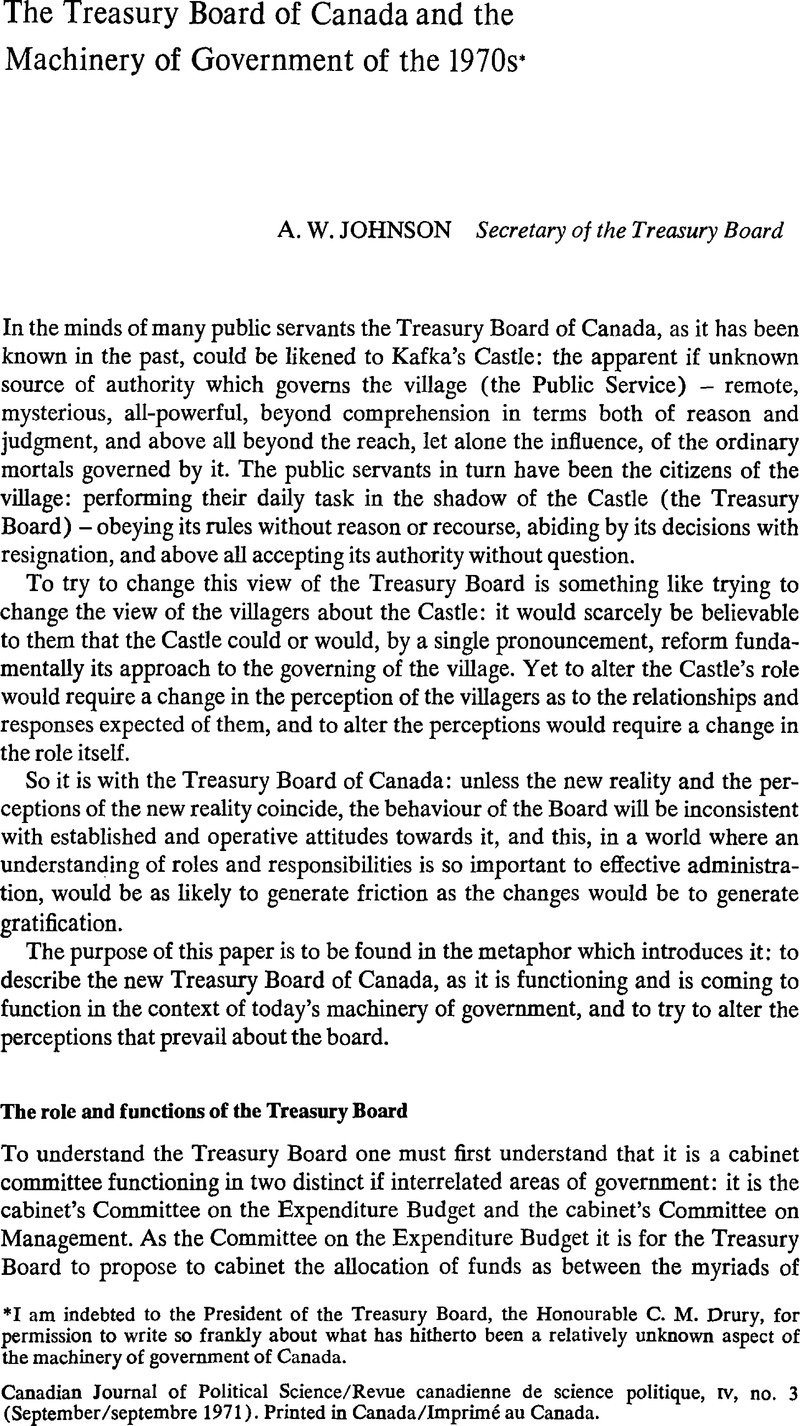Article contents
The Treasury Board of Canada and the Machinery of Government of the 1970s*
Published online by Cambridge University Press: 10 November 2009
Abstract

- Type
- Articles
- Information
- Canadian Journal of Political Science/Revue canadienne de science politique , Volume 4 , Issue 3 , September 1971 , pp. 346 - 366
- Copyright
- Copyright © Canadian Political Science Association 1971
References
1 In fact, of course, the prime responsibility for the evaluation of program effectiveness and administrative efficiency does rest with operating departments. But the collectivity of ministers – the cabinet – relies upon the Treasury Board to ensure that departments have in fact discharged this responsibility.
2 It need hardly be said that the changes described in this paper have taken, and are taking place over time. It is not possbile, therefore, short of an historical account, which is not the purpose of this paper, to record the contributions which have been made by each of the several Presidents and Secretaries of the Board.
3 No attempt is made here to elaborate upon the theories of planning and budgeting as I interpret them. I have attempted to do this in three other articles: “Planning and Budgeting,” Canadian Public Administration, II, no. 3 (Sept. 1959), p. 145; “Efficiency in Government and Business,” ibid., VI, no. 3 (Sept. 1963), p. 245; “ppb and Decision-making in the Government of Canada,” Cost and Management, March-April 1971, p. 12.
4 The formal constitution and terms of reference of the Treasury Board are set out in the Financial Administration Act, principally in sections 3 to 7 inclusive. On the expenditure budget side it is provided that the Board “may act for the Queen's Privy Council for Canada” in “the review of annual and longer term expenditure plans and programmes of the various departments of Government, and the determination of priorities with respect thereto”; in the evaluation of the efficiency of programme administration (“the organization of the public service or any portions thereof…”, “… ensuring effective coordination of administrative functions and services among and within departments…”, and “… the assessment of the (administrative) performance of portions of the public service…”); and the preparation of the Annual and Supplementary Estimates.
5 This section, and indeed the whole of this paper, centres largely on the role and functioning of cabinet committees. It goes without saying that individual ministries remain responsible for, and continue to be looked to for, the program proposals and initiatives which enter in the deliberations of the cabinet and its committees.
6 Non-budgetary expenditures are disbursements which result in the acquisition of a financial asset (a loan to a Crown corporation, for example) or the reduction of a financial liability (the redemption of a part of the public debt, for example), and non-budgetary revenues are receipts which result from a reduction in some financial asset (the repayment of a loan by a Crown corporation, for example), or the incurring of a financial liability (an increase in the public debt, for example). Since these transactions are not generally understood, what is written here centres on budgetary revenues and expenditures.
7 Many important details have been omitted from this account, such as the manner in which capital expenditures are treated in comparison with ordinary expenditures, the use of three-year forecasts for ordinary expenditures and five-year forecasts for capital expenditures, and special functional or regional analyses and evaluations of the expenditure estimates. There simply was not room for all of this within the compass of a single paper.
8 More is said about this in the article “ppb and Decision-making in the Government of Canada,” cited earlier.
9 The formal analysis of program effectiveness has only recently been introduced into government in Canada, so its pervasiveness and impact must not be exaggerated. See again, “ppb and Decision-making in the Government of Canada.”
10 It is provided in the Financial Administration Act that the Treasury Board “may act for the Queen's Privy Council for Canada on all matters relating to… general administrative policy in the public service,” “personnel management in the public service…,” “the organization of the public service or any portion thereof…,” “the establishment of general administrative standards of performance” in the public service, “financial management…,” and the prescribing of “the manner and form in which the accounts of Canada and the accounts of the several departments shall be kept…”
11 A fairly elaborate advisory apparatus exists in the field of personnel management, including the National Joint Council (of employee and employer representatives), and including from the private sector the Advisory Group on Executive Compensation in the Public Service. What is being described here are the statutory responsibilities of the Treasury Board in this field.
- 5
- Cited by


